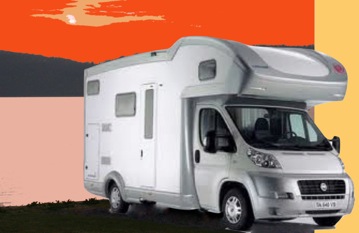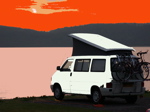
campervanstuff.com
Order
online - or call 01759 304561

 |
campervanstuff.com |
 |
|
||||||||||||||||||||||||||||||||||||||||||||||||||||||||||||||||||||||||||||||
Secure Payments |
Reich Caravan Weight Control Scales 1000kg Per Wheel Motorhome Caravan Safety
It is very easy to overload your vehicle without realising it - and put your safety at serious risk while also making you liable to prosecution. An overloaded vehicle will have impaired handling and will impose great strain on tyres, with increased risk of a dangerous blowout. Motorhome payloads are always being squeezed: built-in equipment already accounts for much of the base vehicle's carrying capacity. Add driver and fuel and what's left is your payload - and this can be surprisingly small. A moderate amount of gear, a travelling companion or two and clothing, food and water can easily take up most of this payload but it is easy to forget this vital factor when you are tempted to throw in a few extras - generator, bicycles .... And of course you might have already eaten up a good part of your payload by adding permanent extras like solar panels, satellite domes, racks and other items. The Reich Caravan-Weight-Control is your very own 'weigh-bridge' - and you can take it with you and make sure that you stay safe if you tend to add more and more to your load as your holiday progresses. As well as being safer, you save the inconvenience of having to find a weigh-bridge and drive there, as well as the cost which could mount up if you are diligent (as you should be) about keeping within your vehicle's legal weights. Your motorhome will carry a plate showing it's maximum legal overall travelling weight plus the maximum weight which can be born by the front axle and by the rear axle. The Caravan-Weight-Control allows you to measure all of these with great accuracy. Using the CWC is very simple. Switch on the scale and with the menu button choose the right programme: vehicle (motorhome) or caravan / trailer (one axle or tandem axle). The display shows symbols for the chosen vehicle type. Then simply place the unit at a right angle in front of or behind the wheel indicated on the display and drive over the scale as slowly as possible. You can then read the wheel load of the wheel in question. By pressing the menu button, the next wheel is indicated. After repeating the procedure for each wheel you know the single wheel loads; then press the 'Total' button and the total weight of the vehicle will be indicated. Technical details:
Note: the capacity of this version is 1000kg per wheel which makes this unit suitable for most small or medium sized motorhomes but please satisfy yourself on this point before ordering. There is a heavier version here: 1500kg version. You should check the plated weight details on your vehicle to establish that the maximum permissible fully loaded weight does not exceed 2000 kg for either the front or rear axle: since the CWC could not register over 1000 kg per wheel (and therefore 2000 kg per axle) you would not be able to weigh up to the full load which can be carried legally by the vehicle. Download the user manual for the Reich Weight Control Why we rate it GREAT STUFF! Having changed our motorhome our first jaunts were short trial breaks. Then we added a few fixtures and fittings, and then a few more. When the time came for our first longer excursion the supplies that were being packed were also piling up and I was worried about our loading weight. I wasn't going to take any chances of having overloaded suspension and tyres through the long, fast and hot runs across France so I took the motorhome to the nearest weighbridge. It wasn't convenient and it wasn't cheap but it was worth it because I found that the motorhome was already overloaded - and still with only the driver on board. This discovery enforced some re-evaluation of our supplies and equipment for that trip; it wasn't really difficult to unload the extra weight but if we had set off without knowing the true situation we might have carelessly added even more weight as the holiday progressed - possibly with dire consequences. Now I use the CWC whenever we change fittings in the motorhome (not infrequently) or when preparing for a journey where we want to load up as much as possible within our weight limits. The CWC also travels with us, just in case my wife wants to carry back a heavy stone sink (does happen you know; I remember well even though it was many years ago, my prized VW Golf which arrived home from holiday squatting very low on the back wheels and staying that way after we unloaded it. New rear shock-absorbers were not cheap either). With the CWC I quickly test the loading without having to leave home - well, not absolutely true because I do prefer to drive to a level area in the village before weighing. For best accuracy the CWC should be used on a level area so that vehicle's angle - and therefore weight distribution - is not changing during the weighing of consecutive wheels. The instructions also suggest placing a short plank of wood the same thickness as the CWC - 25mm - in front of the opposite wheel on the same axle so that the weight distribtuion is not swayed from one side to the other as you drive over the CWC. It's important to drive slowly over the CWC but if you take it too quickly the display shows an error which warns that the weigh was too fast - in which case you simply repeat the weigh for that wheel; the result for each wheel is stored separately so you can re-weigh one wheel without affecting the other results. I find that it is easier to drive slowly and smoothly over the CWC if I have an outside observer who can signal that the wheel is about to move over the CWC. Also that your aim is not going to take the wheel over the CWC's display which is a no-no. It is worth noting that because the CWC weighs each wheel individually you are able to discern not only the front / back axle weight distribution of the vehicle but also the side-to-side weight distribution. Although much of the weight distribution is outside your control, being dependent on the layout of heavy items like furnishings and appliances, batteries and fuel and water tanks, if you are aware of the weights you might be able to improve things by altering the way you pack. Here's an example from a trial 'weigh' of our motorhome. It has a maximum permissible loaded weight of 2,800 kg with a maximum loading on the front 'axle' of 1510 kg and on the rear 'axle' 1490 kg. The combined maximum front and rear loadings exceed the maximum overall weight so it is the latter that is most likely to be reached (or breached) first. The motorhome was partly packed - all supplies and equipment on board except for food and personal items such as clothing and toiletries. Cycles and outdoor chairs were not on board (not required for this trip) and fresh water and waste water tanks were empty. Only the driver was on board and the fuel gauge was showing one-quarter full. I have created a table, below, which shows the results of weighing each wheel (all weight in kg). Note that the motorhome is left-hand drive so the weight of the driver (included) is on the left side. Bear in mind that there would be some variability if you carried out the same weigh repeatedly because each time the speed and smoothness of travel over the unit would never be exactly the same. However I would expect these differences to be within the overall practical tolerance indicated by Reich.
So in this example I had just 180 kg available and still had to accommodate the items below:
So that's how I could stay within the maximum weight. Of course if I was taking the outdoor chairs (about 7kg the pair) and the bicycles (about 20 kg the pair) I would have to do some extra trimming ... In practice, if I knew that the loading for a trip was going to be very tight I would weigh again when absolutely everything was packed, just to be sure. Versatile programmes The CWC has three standard programmes: to weigh caravans and trailers - one for single axles and one for twin axle - as well as one for motorhomes / vehicles. A flashing icon indicates on a diagram which is the current wheel to be weighed; after this wheel is weighed successfully you press a button and the icon moves to the next wheel in the normal sequence for that programme. When all the wheels have been weighed the 'Total' button can be used to display the totals for each side of the vehicle and for the overall weight. The weights for each axle are not tallied automatically but this is easy to do work out for yourself from the individual wheel weights, as in the tables above.
In this display in the motorhome / vehicle programme the left-front wheel icon is highlighted. The readout shows a weight of 86 kg - which is ....errr.... my weight because I stood on it to show some sort of reading...
Caravan / trailer programme, single axle .
Caravan / trailer programme, twin axle.
|
| ||||||||||||||||||||||||||||||||||||||||||||||||||||||||||||||||||||||||||||
| Copyright enetgy limited 2006 - enetgy.co.uk | ||||||||||||||||||||||||||||||||||||||||||||||||||||||||||||||||||||||||||||||